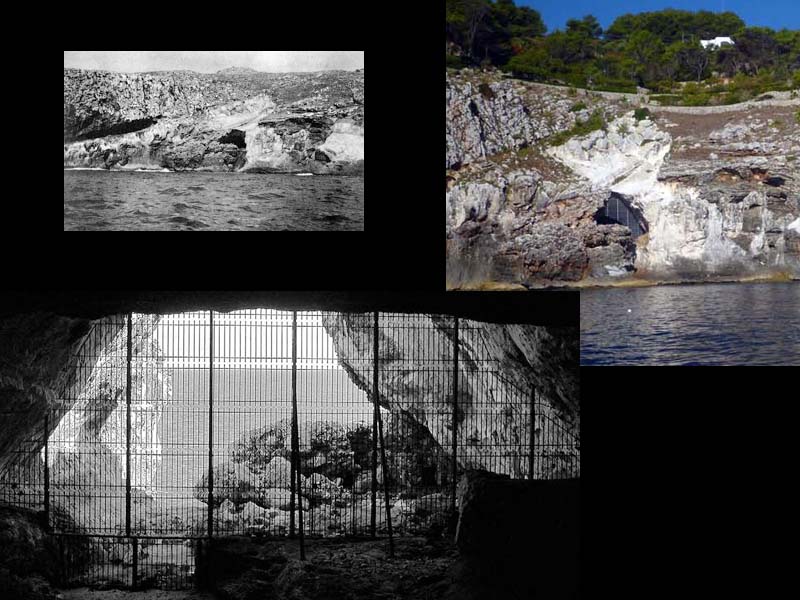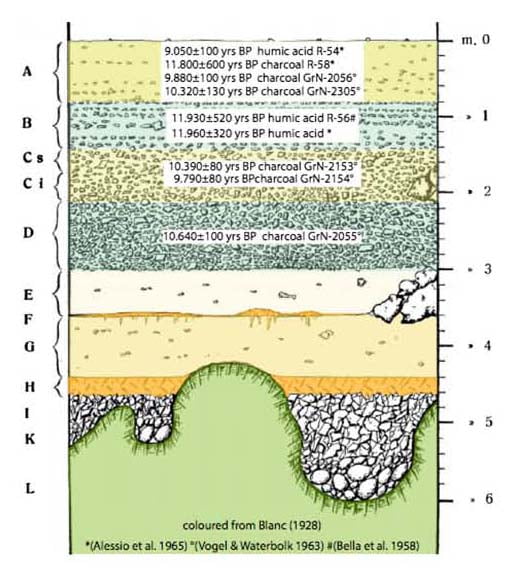di Elvira Visciola
In October 2021 they were published in the magazine “Antiquity” the results of the investigations inside Grotta Romanelli (see card), with the discovery of new wall engravings, about 31 new graphic units, including the figure of a bovid, a rare depiction of a boreal penguin and some geometric and linear signs, which emerged during the recent excavation campaign which began in 2016 and was coordinated by Professor Raffaele Sardella of the Department of Earth Sciences of the Sapienza University of Rome.
The first discoveries in the area date back to 1869, when the Tuscan Ulderigo Botti, a Salento geology enthusiast, following fossil discoveries during an excursion to nearby Capo di Leuca hypothesized the presence of prehistoric man since ancient times. But it was only in the early 900s that systematic research began which led to the discovery of the cave by the paleoanthropologist Ettore Regalia and the Salento painter Paolo Emilio Stasi, until the discovery of fossils, engraved bone objects and the graffiti of a bovid (bos primigenius) on the north wall of the cave, all elements that allowed the Upper Paleolithic to be recognized for the first time in Italy.

The echo of these finds aroused a heated debate in Italy, above all because Luigi Pigorini, a well-known Italian paleontological archaeologist, was skeptical with this dating, attributing the site to the most recent Neolithic, despite the fact that among the finds there were no traces of pottery shards typical of Neolithic stations; he concluded the debate by writing that “…nothing Paleolithic had come out of the Romanelli Cave…".
Fortunately, in 1914 the superintendency of excavations in Puglia commissioned Baron Gian Alberto Blanc, pioneer of paleontological studies in Italy, to carry out a systematic exploration of the site of Romanelli, with the reconstruction, through a complex stratigraphy, of the different phases of life inside the cave, representing in the early 900s, the first certified Italian evidence of Upper Palaeolithic and rock art in the Mediterranean area of Europe.
Decades of in-depth research saw the succession of eminent researchers, including the abbot Henri Breuil, Hugo Obermaier, Alberto Carlo Blanc (son of Gian Alberto), Paolo Graziosi and Paolo Cassoli, investigations that continued until the early 70s when they ceased all research activities inside the cave.
After about 40 years of inactivity, in 2016 the investigations coordinated by the University of Rome La Sapienza resumed, with the authorization of the Superintendency for Archaeological Heritage of Puglia. The new studies, carried out by a multidisciplinary team made up of prehistoric archaeological researchers, paleontologists and geologists, have investigated the previously identified layers with a more modern approach and through the use of new technologies such as to allow a more precise and in-depth dating; in particular, the levels of the "red earth" were investigated, which have backdated the chronological interval of the deposit of the cave to more than one hundred thousand years. Furthermore, a complete topographic survey of the cave was carried out, with the production of a 3D graphic model of all the morphology, including the chromatic details of the excavation areas and petroglyphs.
And it is with these studies that we have come to the discovery of important finds of exquisite workmanship that have meant that the Romanelli Cave leapt into the news as a key site of the Paleolithic in Europe.
The fieldwork was concentrated in the inner chamber of the cave, in two previously unexplored areas, labeled with GRP002 and GRP005.
Area GRP002 has a single panel of engraved art, called A, measuring 58 cm. for 61 in height, located at about 4.20 m above the zero level, i.e. above the lowest point of the floor of the cave (at about 7 m above sea level); the panel has a grid-like reticulated pattern.
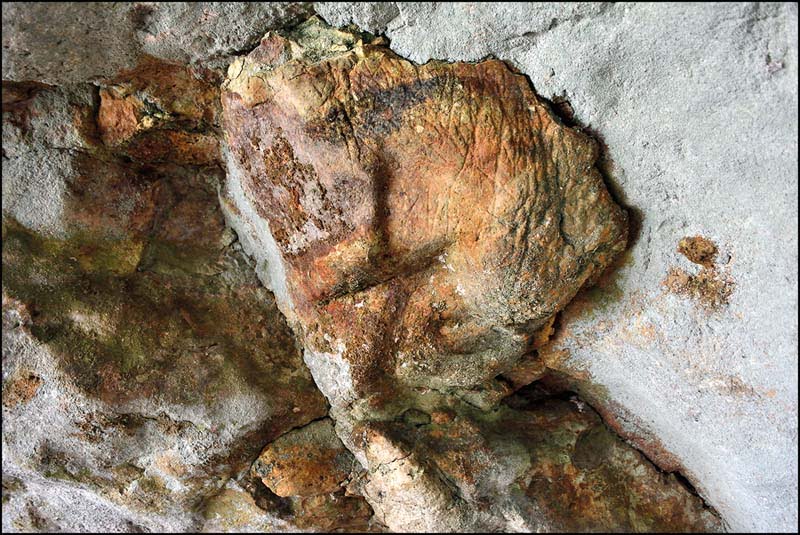
In area GRP005, around 10 panels have instead been identified, of which only 3 (panels E, F and H) present a rich concentration of graphic signs of wall art, around 30 individual figures with zoomorphic and geometric motifs. In particular, panel F is the most interesting, with the representation of the head and back of a bovid with the horns stretched forward and with the representation of an ornithomorphic figure, the northern penguin, with the head, beak and one eye ; both images are crossed by engraved lines of different trends. It should be noted that the particular shape of the rock near the bovid creates a three-dimensional effect outlining the animal's body.
These new finds at Romanelli show probable stylistic connections with other examples of Paleolithic art from the Franco-Cantabrian area (Niaux, Lascaux, Font-de-Gaume, Cosquer, El Pendo Cave), demonstrating the high mobility during the Upper Paleolithic in a large area of Eurasia.
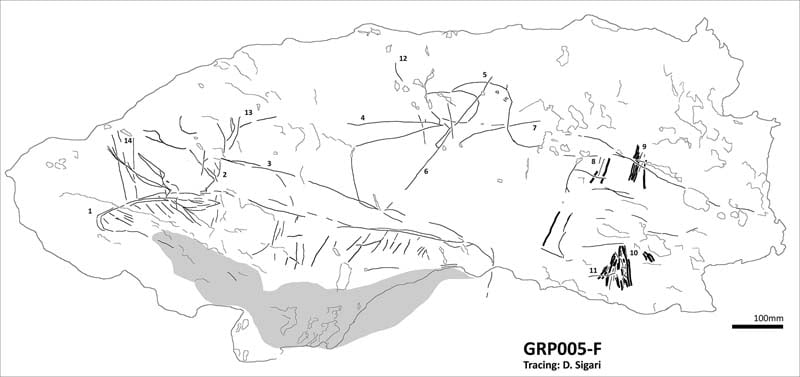
Of particular importance on the panel called E is a winding figure that develops around a vertical axis (a figure already identified in the French caves) and a spindle-shaped one that refers to other similar ones already found inside the cave (see the female fusiform silhouette engraved on the south wall of the cave).
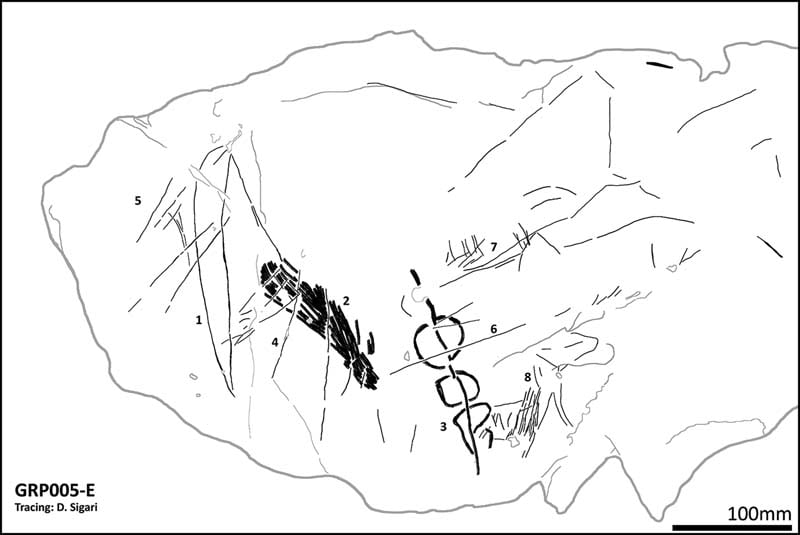
The investigations carried out made it possible to find the use of four different engraving techniques and signs of application directly with the fingers on the rock of a natural pigment known as "moon milk".
Also during these recent excavation activities, new chronological data were obtained through radiocarbon analysis of the sediments, with the confirmation of human occupation of the cave between 11.000 and 14.000 years ago, during which “… a graphic palimpsest that records various artistic episodes and the possibility of older chronologies …” (D. Sigari and others, 2021), the latter still to be investigated.
Elvira Visciola, November 2021
REFERENCES
1. Luca Forti, Ilaria Mazzini, Beniamino Mecozzi, Dario Sigari and Raffaele Sardella – “Grotta Romanelli (Castro, Lecce) A key site of the Mediterranean Quaternary” – in Geologicamente” Geoscience current and cultural magazine – no. July 2, 2020;
2. Raffaele Sardella and Dario Sigari – “Grotta Romanelli in Terra d'Otranto: site and research” – in Signs from Prehistory, sites of Italian rock art in the Archive of the Italian Institute of Prehistory and Protohistory – Florence 2018;
3. Raffaele Sardella and Dario Sigari – “Grotta Romanelli in Terra d'Otranto: The photos of the IIPP archive as a support for conservation” – in Signs from Prehistory, sites of Italian rock art in the Archive of the Italian Institute of Prehistory and Protohistory – Florence 2018;
4. Raffaele Sardella, Ilaria Mazzini, Francesca Giustini, Beniamino Mecozzi, Mauro Brilli, Dawid Adam Iurino, Giuseppe Lembo, Brunella Muttillo, Massimo Massussi, Dario Sigari, Sonia Tucci and Mario Voltaggio – “Grotta Romanelli (Southern Italy, Apulia): legacies and issues in excavating a key site for the Pleistocene of the Mediterranean” – in Italian Journal of Paleontology and Stratigraphy – July 2018;
5. Margherita Mussi, Paul Bahn, Alessandro De Marco and Roberto Maggi – “New discoveries of Palaeolithic wall art in Italy: the Caverna delle Arene Candide and Grotta Romanelli” – in Alpine prehistory – no. 46 - Trento 2012;
6. Margherita Mussi and Alessandro De Marco – “A Gonnersdorf-style engraving in the parietal art of Grotta Romanelli (Apulia, southern Italy)” – in Mitteilungen der Gesellschaft fur Urgeschichte – no. 17 - 2008;
7. Dario Sigari, Ilaria Mazzini, Jacopo Conti, Luca Forti, Giuseppe Lembo, Beniamino Mecozzi, Brunella Muttillo and Raffaele Sardella – “Birds and Bovids: new parietal engravings at the Romanelli Cave, Apulia” – in Antiquity – vol. 95, number 383, Cambridge University Press 13 October 2021.

